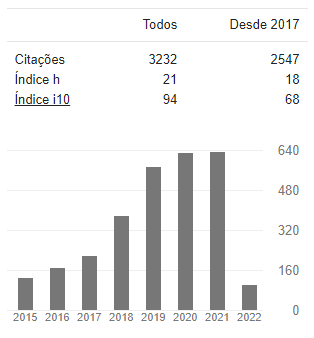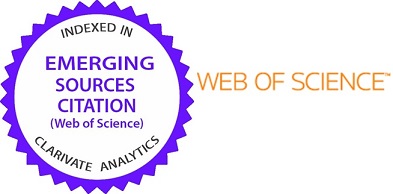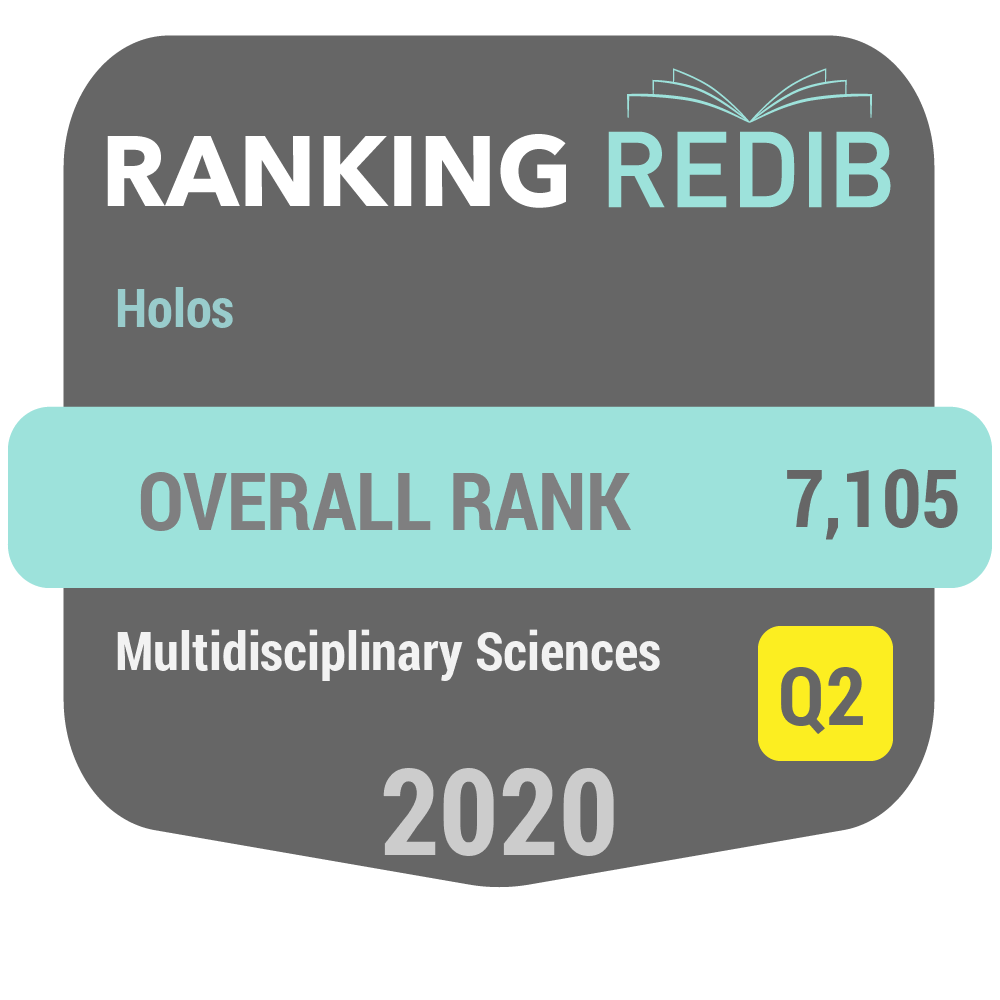ESTUDOS DE EQUILÍBRIO NA SORÇÃO DE Cr(III) POR GRANULADOS BIOCLÁSTICOS
DOI:
https://doi.org/10.15628/holos.2016.5098Palavras-chave:
Tratamento de efluentes, sorção, cromo, alga calcáriaResumo
Os Granulados Bioclásticos provenientes de algas calcárias Lithothamnium calcareum são uma fonte mineral marinha e a sua utilização pode não ser recente, porém ainda necessita de diversas pesquisas para avaliar os seus verdadeiros potenciais e níveis de utilização em diferentes segmentos. Este estudo avalia a aplicação deste material para tratamento de soluções aquosas contendo íons Cr(III) através do processo de sorção. Os resultados de remoção e captação mais significativos de íons Cr(III) foram obtidos na faixa de pH entre 4 a 8, correspondendo a 99,9% e 12,4 mg.g-1, respectivamente. Nas concentrações iniciais de 5 a 200 mg.L-1 foram alcançadas remoções ? 97,9%. Para a captação, o valor mais elevado foi obtido na concentração de 350 mg.L-1, correspondendo a 161 mg.g-1. Os modelos de Langmuir, Dubinin-Radushkevich e Temkin ajustaram-se aos dados de sorção apresentando valores de R2 de 0,953, 0,942 e 0,959, respectivamente. Os valores de qmax obtidos do modelo de Langmuir e de Dubinin-Radushkevich foram de 178,57 mg.g-1 e 171,19 mg.g-1, respectivamente. Os resultados de MEV/EDX mostram precipitados com composição elementar de C, O e Cr.Downloads
Referências
Aziz, H. A., Adlan, M. N., & Ariffin, K. S. (2008) .Heavy metals (Cd, Pb, Zn, Ni, Cu and Cr(III)) removal from water in Malaysia: post treatment by high quality limestone. Bioresource Technology, 99, 1578-1583.
Basha, S., & Murthy, Z. V. P. (2007). Kinetic and equilibrium models for biosorption of Cr(VI) on chemically modified seaweed Cystoseira indica, Process Biochemistry, 42, 1521–1529.
Brasil. Conselho Nacional do Meio Ambiente – CONAMA, (2011). Resolução nº 430 de 13 de maio de 2011. Dispõe sobre condições e padrões de lançamento de efluentes, complementa e altera a Resolução nº 357, de 17 de março de 2005, do Conselho Nacional do Meio Ambiente.
Cetesb – Companhia Ambiental do Estado de São Paulo, (2012). Crômio e seus compostos - Ficha de Informação Toxicológica, 3p. Disponível em: http://www.cetesb.sp.gov.br Acesso em: 04/04/2015
Cheng, L., Sturchio, N. C., Woicik, J. C., Kemner, K. M., Lyman, P. F., Bedzyk, M. J. (1998). High-resolution structural study of zinc ion incorporation at the calcite cleavage surface. Surface Science, 415, 1976–1982.
Dan’azum, S., & Bichi, M. H. (2010). Industrial pollution and heavy metals profile of Challawa river in Kano, Nigeria, Journal of Applied Sciences in Environmental Sanitation, 5, 56–62.
Dias, C. T. M. (2000). Bioclastic Granules: calcareous algae, Brazilian Journal of Geophysics, 8, 307-318.
Du, Y., Lian, F., & Zhu, L. (2011). Biosorption of divalent Pb, Cd and Zn on aragonite and calcite mollusk shells. Environmental Pollution, 159, 1763-1768.
El-Sherif, I. Y., Tolani, S., Ofosu, K., Mohamed, O. A., & Wanekaya, A. K. (2013). Polymeric nano fibers for the removal of Cr(III) from tannery waste water. Journal of Environmental Management, 129, 410-413.
Febrianto, J., Kosasih, A. N., Sunarso, J., Ju, Y., Indraswati, N., & Ismadji, S. (2009). Equilibrium and kinetic studies in adsorption of heavy metals using biosorbent: A summary of recent studies, Journal of Hazardous Materials, 162, 616-645.
Foo, K. Y., & Hameed, B.H. (2010). Insights into the modeling of adsorption isotherm systems, Chemical Engineering Journal, 156, 2–10.
Ford, R. G., Scheinost, A. C., & Sparks, D. L. (2001). Frontiers in metal sorption/precipitation mechanisms on soil mineral surfaces. Advances in Agronomy, 74, 41–62.
Freundlich, H. M. F. (1906). Über die adsorption in lösungen. Zeitschrift für Physikalische Chemie, 57, 385–470.
Frimmel, F. H., & Huber, L. (1996). Influence of humic substances on the aquatic sorption of heavy metals on defined minerals phases. Environmental International, 22, 507–517.
Gadd, G. M. (2009). Biosorption: critical review of scientific rationale, environmental importance and significance for pollution treatment, Journal of Chemical Technology and Biotechnology, 48, 13-28.
Gregg, S. J., & Sing, K. S. W. (1982). Adsorption, Surface area and Porosity. Academic Press, London.
Ho, Y. S., Porter, J. F., & Mckay, G. (2002). Equilibrium isotherm studies for the sorption of divalent metal ions onto peat: copper, nickel and lead single component systems, Water Air Soil Pollution, 141, 1–33.
Ibrahim, M. N. M., Ngah, W. S. W., Norliyana, M. S., Daud, W. R. W., Rafatullah, M., Sulaiman, O., & Hashim, R. (2010). A novel agricultural waste adsorbent for the removal of lead (II) ions from aqueous solutions. Journal of Hazardous Materials, 182, 377–385.
Langmuir, I. (1918). The adsorption of gases on plane surfaces of glass, mica, and platinum, Journal of the American Chemical Society, 40, 1361–1403.
Lee, R. E. (1999). Phycology, 3rd Edition Cambridge : Cambridge University Press, 614 p.
Ma, X., Li, L., Yang, L., Su, C., Wang, K., Yuan, S., & Zhou, J. (2012). Adsorption of heavy metal ions using hierarchical CaCO3–maltose meso/macroporous hybrid materials: Adsorption isotherms and kinetic studies. Journal of Hazardous Materials, 209–210, 467– 477.
Momodu, M. A., & Anyakora, C. A. (2010). Heavy Metal Contamination of Ground Water: The Surulere Case Study. Research Journal Environmental and Earth Sciences, 2(1), 39-43.
Pokrovsky, O. S., & Schott, J. (2002). Surface chemistry and dissolution kinetics of divalent metal carbonates. Environmental Science & Technology, 36, 426-432.
Rangel-Porras, G., García-Magno, J. B., & González-Muñoz, M. P. (2010). Lead and cadmium immobilization on calcitic limestone materials. Desalination, 262, 1–10.
Rostamian, R., Najafi, M., & Rafati, A. A. (2011). Synthesis and characterization of thiol-functionalized silica nano hollow sphere as a novel adsorbent for removal of poisonous heavy metal íons from water: Kinetics, isotherms and error analysis. Chemical Engineering Journal, 171, 1004–1011.
Sanchez, A. G., & Ayuso, E. A. (2002). Sorption of Zn, Cd and Cr on calcite: application to purification of industrial wastewater. Minerals Engineering, 15, 539–547.
Sdiri, A., Higashi, T., Jamoussi, F., & Bouaziz, S. (2012). Effects of impurities on the removal of heavy metals by natural limestones in aqueous systems. Journal of Environmental Management, 93, 245-253.
Sdiri, A., Higashia, T., Hattab, T., Jamoussic, F., & Tase, N. (2011). Evaluating the adsorptive capacity of montmorillonitic and calcareous clays on the removal of several heavy metals in aqueous systems. Chemical Engineering Journal, 172, 37– 46.
Selatnia, A., Bakhti, M. Z., Madani, A., Kertous, L., & Mansouri, Y. (2004). Biosorption de Cd2+ from aqueous solution by a NAOH treated bacterial dead Streptomyces rimosus biomass. Hydrometallurgy, 75, 11-24.
Shahwan, T., Zünbül, B., Tunuso?lu, Ö., & Ero?lu, A. E. (2005). AAS, XRPD, SEM/EDS, and FTIR characterization of Zn2+ retention by calcite, calcite-kaolinite, and calcite-clinoptilolite minerals. Journal of Colloid and Interface Science, 286, 471–478.
Sondi, I., Biscan, J., Vdovic, N., & Skapin, S.D. (2009). The electrokinetic properties of carbonates in aqueous media revisited. Colloids and Surfaces A: Physicochemical and Engineering Aspects, 342, 84–91.
Sparks, D. L. (2005). Sorption | Metals. In: Hillel, D., Hatfield , J. L., Powlson, D. S., Rosenweig, C., Scow, K. M., Singer, M. J., Sparks, D. L. Encyclopedia of Soils in the Environment, Oxford UK: Ed. Elsevier Ltd, 532-537.
Stumm, W., & Morgan, J. J. (1981). Aquatic Chemistry: An Introduction Emphasizing Chemical Equilibria in Natural Waters. 2nd Ed., JoHn Wiley & Sons.
Suwalsky, M., Castro, R., Villena, F., & Sotomayor, C. P. (2008). Cr(III) exerts stronger structural effects than Cr(VI) on the human erythrocyte membrane and molecular models. Journal of Inorganic Biochemistry, 102, 842-849.
Torem, M. L., & Casqueira, R. (2003). Flotação Aplicada à Remoção de Metais Pesados. Série Tecnologia Ambiental, 28: CETEM. Rio de Janeiro.
Wang, J., & Chen, C. (2006). Biosorption of heavy metals by Saccharomyces cerevisiae: a review. Biotechnology Advances, 24, 427–451.
Wang, X., Huang, J., Huai, Q., Wang, J., & Qin, Y. (2007). Determination of kinetic and equilibrium parameters of the batch adsorption of Ni(II) from aqueous solutions by Na-Mordenite, Journal of Hazardous Materials, 142, 468-476.
Zouboulis, A. I., Loukidou, M. X., & Matis, K. A. (2004). Biosorption of toxic metals from aqueous solutions by bacteria strains isolated from metal-polluted soils. Process Biochemistry, 39, 909–916.









































